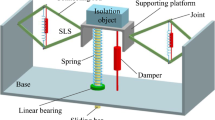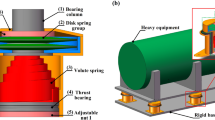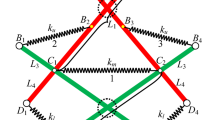Abstract
Most existing quasi-zero stiffness (QZS) vibration isolators with excellent vibration isolation performance focus on suppressing single-directional vibration. There are limitations to applications. In this paper, a multidirectional vibration isolation system with the QZS effect is proposed based on the designed geometrical relationship between the torsion spring and the linear spring. The effect of the mechanism’s structural parameters on its static as well as dynamic characteristics is analyzed. The results reveal that (a) consisting only of elastic elements and connecting rods, the compact mechanism has ideal vibration isolation performance in all three directions; (b) the mechanism characteristics can be flexibly adjusted by tuning the structural parameters; (c) when the excitation amplitudes are large, the vibration isolator remains preferable vibration attenuation performance; (d) compared with the traditional QZS structure, the typical X-shaped QZS structure, and the proposed structure I, the designed structure has a larger QZS area and a wider vibration attenuation area in the main vibration isolation direction.



















Similar content being viewed by others
Data availability
The datasets generated during the current study are available from the corresponding author on reasonable request.
References
Chai, Y.Y., Jing, X.J., Chao, X.: X-shaped mechanism based enhanced tunable QZS property for passive vibration isolation. Int. J. Mech. Sci. 218, 107077 (2022)
Li, H., Li, Y.C., Li, J.C., et al.: Negative stiffness devices for vibration isolation applications: a review. Adv. Struct. Eng. 23(8), 1739–1755 (2020)
Xing, Z.Y., Yang, X.D.: A combined vibration isolation system capable of isolating large amplitude excitation. Nonlinear Dyn. 112, 2523–2544 (2024)
Hao, Z., Cao, Q., Wiercigroch, M.: Nonlinear dynamics of the quasi-zero-stiffness SD oscillator based upon the local and global bifurcation analyses. Nonlinear Dyn. 87(2), 987–1014 (2017)
Zhao, F., Ji, J., Ye, K., et al.: Increase of quasi-zero stiffness region using two pairs of oblique springs. Mech. Syst. Signal Process. 144, 106975 (2020)
Zhao, F., Ji, J.C., Ye, K., et al.: An innovative quasi-zero stiffness isolator with three pairs of oblique springs. Int. J. Mech. Sci. 192, 106093 (2021)
Yan, G., Wu, Z.Y., Wei, X.S., et al.: Nonlinear compensation method for quasi-zero stiffness vibration isolation. J. Sound Vib. 523, 116743 (2022)
Zhao, F., Cao, S.Q., Luo, Q.T., et al.: Practical design of the QZS isolator with one pair of oblique bars by considering pre-compression and low-dynamic stiffness. Nonlinear Dyn. 108, 3313–3330 (2022)
Papaioannou, G., Voutsinas, A., Koulocheris, D.: Optimal design of passenger vehicle seat with the use of negative stiffness elements. Proc. Inst. Mech. Eng. Part D J. Automob. Eng. 234(2–3), 610–629 (2020)
Yan, G., Zou, H.X., Wang, S., et al.: Large stroke quasi-zero stiffness vibration isolator using three-link mechanism. J. Sound Vib. 478, 115344 (2020)
Gatti, G., Shaw, A.D., Gonçalves, P.J.P., et al.: On the detailed design of a quasi-zero stiffness device to assist in the realisation of a translational Lanchester damper. Mech. Syst. Signal Process. 164, 108258 (2022)
Zou, S., Wang, D.Y., Zhang, Y.S.: Design and testing of a parabolic cam-roller quasi-zero-stiffness vibration isolator. Int. J. Mech. Sci. 220, 107146 (2022)
Ye, K., Ji, J., Brown, T.: A novel integrated quasi-zero stiffness vibration isolator for coupled translational and rotational vibrations. Mech. Syst. Signal Process. 149, 107340 (2021)
Zhang, Y., Wei, G., Wen, H., et al.: Design and analysis of a vibration isolation system with cam–roller–spring–rod mechanism. J. Vib. Control 28(13/14), 1781–1791 (2022)
Yao, Y., Li, H., Li, Y., et al.: Analytical and experimental investigation of a high-static-low-dynamic stiffness isolator with cam-roller-spring mechanism. Int. J. Mech. Sci. 186, 105888 (2020)
Xu, J.W., Yang, X.F., Li, W., et al.: Design of quasi-zero stiffness joint actuator and research on vibration isolation performance. J. Sound Vib. 479, 115367 (2020)
Zheng, Y., Zhang, X., Luo, Y., et al.: Analytical study of a quasi-zero stiffness coupling using a torsion magnetic spring with negative stiffness. Mech. Syst. Signal Process. 100, 135–151 (2018)
Wang, Q., Zhou, J.X., Wang, K., et al.: Design and experimental study of a compact quasi-zero-stiffness isolator using wave springs. Sci. China Technol. Sci. 64, 2255–2271 (2021)
Wu, M.K., Wu, J.L., Che, J.X., et al.: Analysis and experiment of a novel compact magnetic spring with high linear negative stiffness. Mech. Syst. Signal Process. 198, 110387 (2023)
Yan, B., Yu, N., Wang, Z.H., et al.: Lever-type quasi-zero stiffness vibration isolator with magnetic spring. J. Sound Vib. 527, 116865 (2022)
Chen, R.Z., Li, X.P., Tian, J., et al.: On the displacement transferability of variable stiffness multi-directional low frequency vibration isolation joint. Appl. Math. Model. 112, 690–707 (2022)
Lian, X.Y., Deng, H.X., Han, G.H., et al.: A low-frequency micro-vibration absorber based on a designable quasi-zero stiffness beam. Aerosp. Sci. Technol. 132, 108044 (2023)
Zhang, C., He, J.S., Zhou, G.Q., et al.: Compliant quasi-zero-stiffness isolator for low-frequency torsional vibration isolation. Mech. Mach. Theory 181, 105213 (2023)
Dalela, S., Balaji, P.S., Jena, D.P.: Design of a metastructure for vibration isolation with quasi-zero-stiffness characteristics using bistable curved beam. Nonlinear Dyn. 108, 1931–1971 (2022)
Lu, D.C., Zhou, Y., Ma, K.Q., et al.: Investigation on the free vibration characteristics of vertical quasi-zero stiffness isolation system considering the disc spring’s loading position. Soil Dyn. Earthq. Eng. 178, 108484 (2024)
Chen, P., Wang, B., Zhou, D.S., et al.: Performance evaluation of a nonlinear energy sink with quasi-zero stiffness property for vertical vibration control. Eng. Struct. 282, 115801 (2023)
Ye, K., Ji, J.C.: An origami inspired quasi-zero stiffness vibration isolator using a novel truss-spring based stack Miura-ori structure. Mech. Syst. Signal Process. 165, 108383 (2022)
Han, H.S., Sorokin, V., Tang, L.H., et al.: Lightweight origami isolators with deployable mechanism and quasi-zero-stiffness property. Aerosp. Sci. Technol. 121, 107319 (2022)
Inamoto, K., Ishida, S.: Improved feasible load range and its effect on the frequency response of origami-inspired vibration isolators with quasi-zero-stiffness characteristics. J. Vib. Acoust. 141(2), 021004 (2019)
Sadeghi, S., Li, S.: Fluidic origami cellular structure with asymmetric quasi-zero stiffness for low-frequency vibration isolation. Smart Mater. Struct. 28(6), 065006 (2019)
Liu, S.W., Peng, G.L., Jin, K.: Towards accurate modeling of the Tachi-Miura origami in vibration isolation platform with geometric nonlinear stiffness and damping. Appl. Math. Model. 103, 674–695 (2022)
Liu, S.W., Peng, G.L., Li, Z.X., et al.: Design and experimental study of an origami-inspired constant-force mechanism. Mech. Mach. Theory 179, 105117 (2023)
Fulton, F., Sorokin, V.S.: Analysis of the effects of nonlinear damping on a multiple-degree-of-freedom quasi-zero-stiffness vibration isolator. Mech. Res. Commun. 130, 104121 (2023)
Han, H.S., Tang, L.H., Wu, J.N., et al.: Origami-inspired isolators with quasi-zero stiffness for coupled axial-torsional vibration. Aerosp. Sci. Technol. 140, 108438 (2023)
Chai, Y.Y., Jing, X.J., Guo, Y.Q.: A compact X-shaped mechanism based 3-DOF anti-vibration unit with enhanced tunable QZS property. Mech. Syst. Signal Process. 168, 108651 (2022)
Chai, Y.Y., Jing, X.J.: Low-frequency multi-direction vibration isolation via a new arrangement of the X-shaped linkage mechanism. Nonlinear Dyn. 109, 2383–2421 (2022)
Sun, X.T., Jing, X.J., Xu, J., et al.: Vibration isolation via a scissor-like structured platform. J. Sound Vib. 333(9), 2404–2420 (2014)
Sun, X.T., Jing, X.J.: Analysis and design of a nonlinear stiffness and damping system with a scissor-like structure. Mech. Syst. Signal Process. 66–67, 723–742 (2016)
Wei, C.F., Zhang, K.J., Hu, C., et al.: A tunable nonlinear vibrational energy harvesting system with scissor-like structure. Mech. Syst. Signal Process. 125, 202–214 (2019)
Sun, X.T., Jing, X.J.: A nonlinear vibration isolator achieving high-static-low-dynamic stiffness and tunable anti-resonance frequency band. Mech. Syst. Signal Process. 80, 66–188 (2016)
Sun, X.T., Jing, X.J.: Multi-direction vibration isolation with quasi-zero stiffness by employing geometrical nonlinearity. Mech. Syst. Signal Process. 62–63, 149–163 (2015)
Zeng, R., Wen, G.L., Zhou, J.X., et al.: Limb-inspired bionic quasi-zero stiffness vibration isolator. Acta Mech. Sin. 37, 1152–1167 (2021)
Chen, T.F., Zheng, Y.X., Song, L.H., et al.: Design of a new quasi-zero-stiffness isolator system with nonlinear positive stiffness configuration and its novel features. Nonlinear Dyn. 111, 5141–5163 (2023)
Yan, G., Qi, W.H., Lu, J.J., et al.: Bio-inspired multi-joint-collaborative vibration isolation. J. Sound Vib. 568, 118089 (2024)
Tutsoy, O., Polat, A.: Linear and non-linear dynamics of the epidemics: System identification based parametric prediction models for the pandemic outbreaks. ISA Trans. 124, 90–102 (2022)
Tutsoy, O., Tanrikulu, M.Y.: Priority and age specific vaccination algorithm for the pandemic diseases: a comprehensive parametric prediction model. BMC Med. Inform. Decis. Mak. 22(1), 1–12 (2022)
Ermentrout, B.: Simulating, analyzing, and animating dynamical systems: a guide to XPPAUT for researchers and students. SIAM, Philadelphia (2002)
Dai, H.H., Jing, X.J., Wang, Y., et al.: Post-capture vibration suppression of spacecraft via a bio-inspired isolation system. Mech. Syst. Signal Process. 105, 214–240 (2018)
Acknowledgements
This research is supported by the Natural Science Foundation of Liaoning (2020-MS-092).
Funding
The authors have not disclosed any funding.
Author information
Authors and Affiliations
Corresponding author
Ethics declarations
Conflict of interest
The authors declare that they have no conflict of interest.
Additional information
Publisher's Note
Springer Nature remains neutral with regard to jurisdictional claims in published maps and institutional affiliations.
Appendix A
Appendix A
Rights and permissions
Springer Nature or its licensor (e.g. a society or other partner) holds exclusive rights to this article under a publishing agreement with the author(s) or other rightsholder(s); author self-archiving of the accepted manuscript version of this article is solely governed by the terms of such publishing agreement and applicable law.
About this article
Cite this article
Wang, J., Yao, G. Multi-directional vibration isolation performances of a scissor-like structure with nonlinear hybrid spring stiffness. Nonlinear Dyn (2024). https://doi.org/10.1007/s11071-024-09561-4
Received:
Accepted:
Published:
DOI: https://doi.org/10.1007/s11071-024-09561-4




